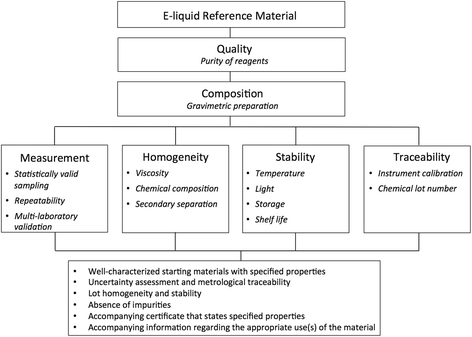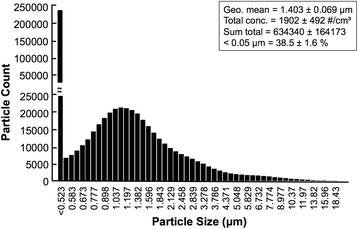Universal electronic-cigarette test: physiochemical characterization of reference e-liquid
- PMID: 28239329
- PMCID: PMC5314484
- DOI: 10.1186/s12971-017-0119-x
Universal electronic-cigarette test: physiochemical characterization of reference e-liquid
Abstract
Background: Despite the rising health and safety concerns of e-cigarettes, a universal e-cigarette testing method is still in its early developmental stage. The aim of this study was to develop an e-liquid Reference Material that can be used to improve accuracy and reproducibility of research results, and advance health risk assessment of e-cigarette products.
Methods: E-liquid Reference Material was developed by purity assessment, gravimetric measurement, homogeneity testing, and stability testing with material and instrument traceability (adopted from ISO 35:2006E).
Results: Homogeneity tests showed e-liquid Reference Material requires ≥ 1 h rotation at a speed of 5 rpm to reach complete homogeneity. Stability tests showed homogeneity is intact for at least 2 weeks without secondary separation, and e-liquids are stable in 21 °C-50 °C thermocycling conditions up to 72 h. A change in the e-liquid color was first observed at day seven, and progressed to 2- and 16 - fold increase in absorbance by one and 6 months respectively. We found that e-liquids do not have inherent material instabilities such as immiscibility or secondary separation. However, discrepancies in concentration and composition arose mainly due to viscosity of propylene glycol and glycerin. Aerosol generated from the e-liquid Reference Material had 16 chemical-byproducts and was composed of ~634,000 particles of which 38% were Fine Particulate Matters (<0.5 μm in diameter).
Conclusions: The efforts described here to create a standardized e-liquid Reference Material aim to provide unbiased and robust testing parameters that may be useful for researchers, the industry and government agencies. Additionally, the reference e-liquid could open a channel of conversation among different laboratories by providing the means of independent verification and validation while establishing a system of transparency and reproducibility in materials and methods.
Keywords: Electronic-cigarette; Reference material; Universal testing method; e-cig; e-liquid.
Figures



References
-
- Johnston LD, O’Mally PM, Miech RA, et al. Monitoring the future. National survey results on drug use: 1975–2014 Overview key findings on adolescent drug use. 2014. http://www.monitoringthefuture.org/pubs/monographs/mtf-overview2014.pdf. Accessed 29 Mar 2016.
-
- World Health Organization . WHO Framework convention on tobacco control electronic nicotine delivery systems. Moscow: Russian Federation; 2014.
LinkOut - more resources
Full Text Sources
Other Literature Sources

